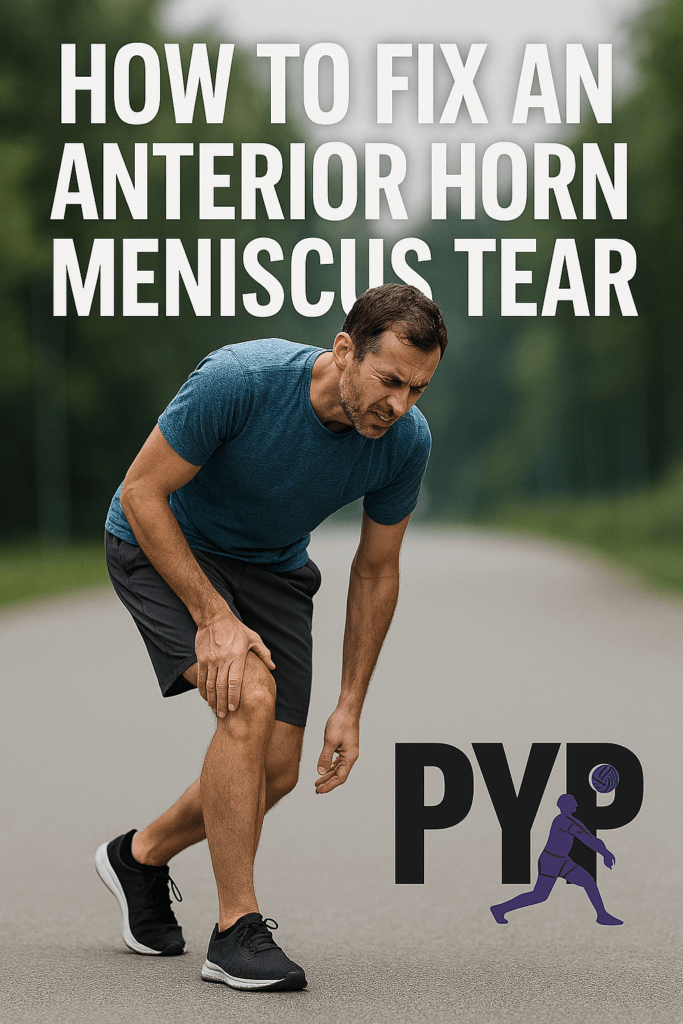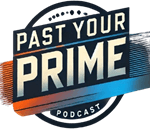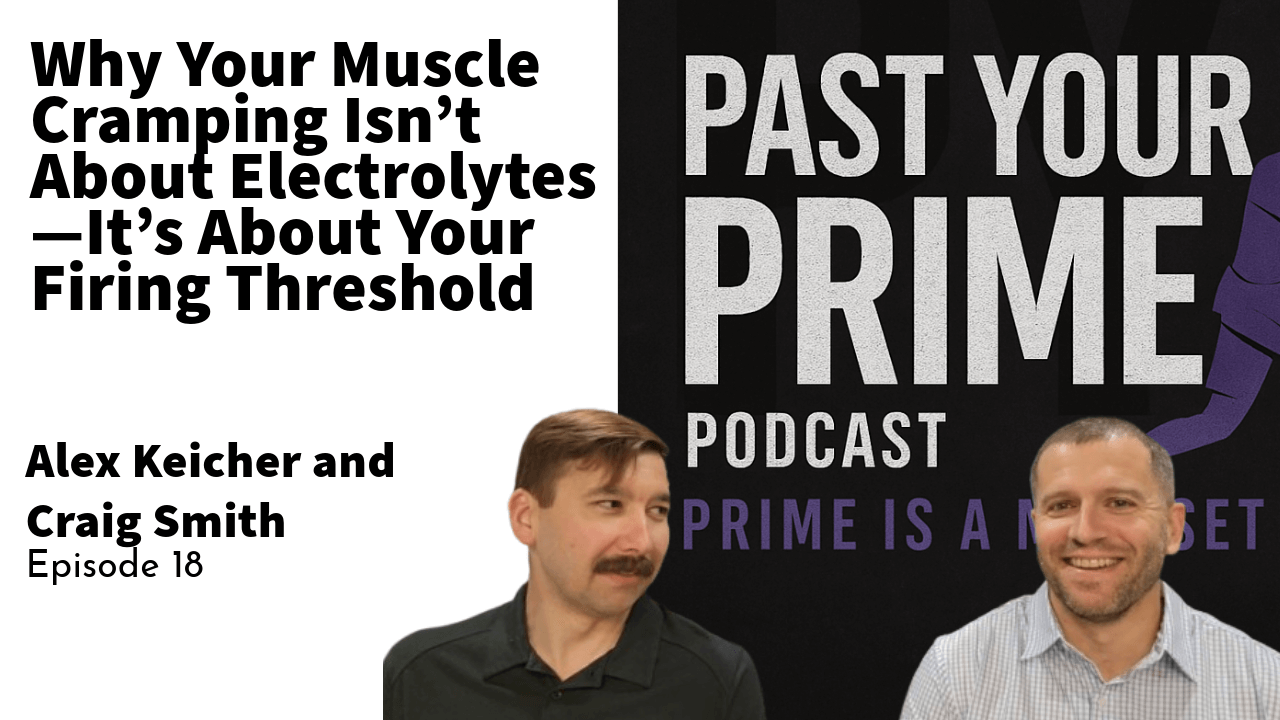Welcome to Episode 12 of the Past Your Prime podcast.
This episode is Part 2 of our series on anterior horn meniscus lesions—an often overlooked but very common source of sharp knee pain, especially when walking, locking out the knee, or standing for long periods.
Listen to Part 1, The Anterior Horn Meniscus: Diagnosis, Key Signs, and Why It’s Often Missed.
Craig (the physical therapist who loves pathology) and Alex (the athlete with enviable calves and a deep voice) dive into how to fix this type of meniscus tear without surgery. From identifying the real problem to applying practical, rehab-first strategies, we walk you through the step-by-step process for recovery.
Whether you’re an athlete, active adult, or just tired of nagging knee pain, this episode gives you the tools to understand and fix an anterior horn tear the right way.
Key Topics Covered
- Manual Therapy & Mobility: How to regain full knee extension (and why it matters more than your glutes in this case)
- Trigger Management: The overlooked impact of your walking mechanics
- Rehab Exercises: What to do—and what to absolutely avoid—when rebuilding strength
- Return to Sport: When you’re ready and how to get there safely
- Prehab Tips: Exercises to manage long term injury reccurence
- Surgery vs. Rehab: Why this isn’t always a surgical case (despite what your MRI says)
What Is an Anterior Horn Meniscus Lesion?
The anterior horn is the front part of the meniscus—your knee’s natural shock absorber. When this area is damaged, it often mimics other injuries like patellar tendinopathy or quad strains, making it easy to misdiagnose. The most obvious sign?
Limited knee extension and sharp pain when walking or locking your leg.
Pro Tip: If you can’t fully extend one knee compared to the other while standing, you may have an anterior horn issue.
How to Treat It (Without Surgery)
Step 1: Regain Full Extension
Full extension is essential. Without it, your gait becomes dysfunctional and continuously aggravates the meniscus.
- Hands-on techniques restore the natural “screw-home mechanism”
- Full demos are available at PastYourPrime.com
Step 2: Rehab Exercises for Knee Meniscus Lesions
Skip the leg extension machine. It loads the knee in the worst way for this injury.
Instead, use exercises that:
- Restore motion
- Strengthen the quad without compressing the meniscus
- Train better mechanics
Top Picks:
- Terminal Knee Extensions with banded anterior pull
- Short Arc Quads (hamstring off!)
- “Spanish” Squats (temporary name, we know…)
- Heel lifts for gait correction
- Reverse Lunges with tibial pull
Some of these movements mimic what we do in manual therapy but give you the independence to continue progress at home. We also discuss how to modify each exercise based on your pain level and current function.

Trigger Management in Rehab for Meniscus Injuries
Walking is the #1 trigger that keeps this injury from healing. Two key contributors:
- Pre-tibial weakness leads to early, uncontrolled extension
- Calf weakness leads to late extension slamming
Use:
- Heel lifts
- Shorter steps
- Tib raises and calf strengthening
These subtle changes can dramatically reduce irritation and allow healing to begin.
We also touch on why even a minor limp can cause long-term dysfunction, and how altering your gait for just a few weeks can be a game changer.
Should You Get Surgery for This Type of Meniscus Tear?
Not unless you have to.
Most anterior horn lesions respond well to conservative care if:
- Knee motion is restored
- Trigger activities are controlled
- The rehab program addresses quad, pre-tib, and calf function
Surgical indications include:
- Bucket handle tears (when part of the meniscus is stuck in the joint)
- Mechanical locking or catching that can’t be managed with rehab
We break down what an MRI might show, and why imaging can sometimes make the injury feel more serious than it is. Getting a second opinion from a physical therapist who understands these injuries can prevent unnecessary procedures.
Returning to Activity After a Front Meniscus Tear
You’re ready when:
- Full extension and flexion are pain-free
- No joint swelling
- Quad strength is restored
Timeline:
- If managed well: 2–3 weeks
- If unmanaged: months (or longer)
For athletes, return to sport can happen quickly—if the extension issue is solved and strength is preserved. We outline a progression that includes pain-free loading, movement re-education, and key checkpoints for safe reintegration.
Prehab & Prevention for Meniscus Health
While our normal walking mechanics predispose all humans to this type of injury, here are some tools to improve resillience.
Focus on:
- Mid-range isometric quad strength
- Strong pre-tibials and calves
- Walking mechanics (don’t slam into extension)
- Cyclical, low-load movements like biking for joint nutrition
We also discuss why young athletes (especially females) need to build joint strength early and how missing key developmental windows may increase injury risk later in life.
Final Thoughts from Craig & Alex on Knee Pain Rehab
Anterior horn meniscus tears don’t have to lead to surgery. But they do require a clear diagnosis and a smart plan. The biggest mistake? Ignoring knee extension loss and continuing to walk the same way.
If you feel like one knee doesn’t extend fully—or your pain spikes with walking—start there. Put a heel lift in. Work your quad. Fix your gait.
And maybe consider the benefits of a half-inch lift for your confidence while you’re at it.
We’ll continue exploring injuries like this that show up on MRI but respond great to rehab—stay tuned for upcoming episodes.
Join the Conversation
Have a knee issue or want your case featured in a future Comments Section? Drop a comment on YouTube or ASK A QUESTION.
Follow us on Instagram:
Craig Smith | Alex Keicher


